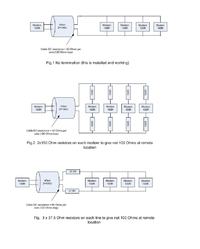kc996
Newbie level 3

- Joined
- Sep 29, 2011
- Messages
- 4
- Helped
- 0
- Reputation
- 0
- Reaction score
- 0
- Trophy points
- 1,281
- Location
- Aberdeen, Scotland
- Activity points
- 1,328
Hi,
we use very basic low frequency 1200baud modems point to point over very long cable runs (up to 40km) To get this distance the cable is thick (5-10sqmm.) The modems are 100 Ohm impedance and the cable Z is also 100 Ohms. This length of cable commonly has a loop resistance(R) of around 120 Ohms.
My question is that although I am theoretically terminating a 100 Ohm impedance cable with the correct 100 Ohm impedance modems on either end does the fact that the cable has so much loop resistance not cause a problem?
For example does the local modem not see an effective load of the cable plus the remote modem giving 220 Ohms which would cause reflections?
Also if I want to put two modems at the remote site I can use a resistive star type splitter at the far end. This would normally use 3 x 33 Ohm resistors to split the signal two ways but keep each modem seeing 100 Ohms impedance, but again doesnt the resistance of the cable upset this?
Thanks very much, Kevin
we use very basic low frequency 1200baud modems point to point over very long cable runs (up to 40km) To get this distance the cable is thick (5-10sqmm.) The modems are 100 Ohm impedance and the cable Z is also 100 Ohms. This length of cable commonly has a loop resistance(R) of around 120 Ohms.
My question is that although I am theoretically terminating a 100 Ohm impedance cable with the correct 100 Ohm impedance modems on either end does the fact that the cable has so much loop resistance not cause a problem?
For example does the local modem not see an effective load of the cable plus the remote modem giving 220 Ohms which would cause reflections?
Also if I want to put two modems at the remote site I can use a resistive star type splitter at the far end. This would normally use 3 x 33 Ohm resistors to split the signal two ways but keep each modem seeing 100 Ohms impedance, but again doesnt the resistance of the cable upset this?
Thanks very much, Kevin





